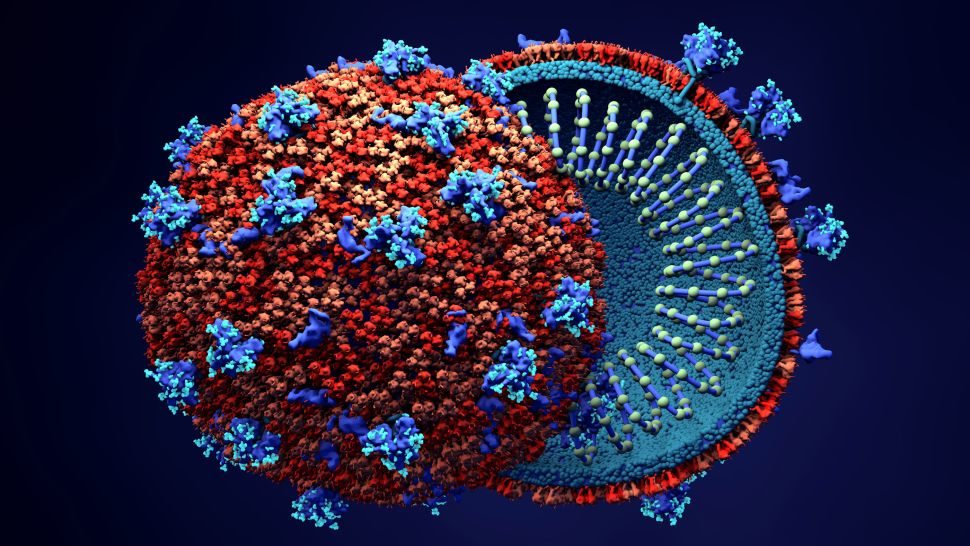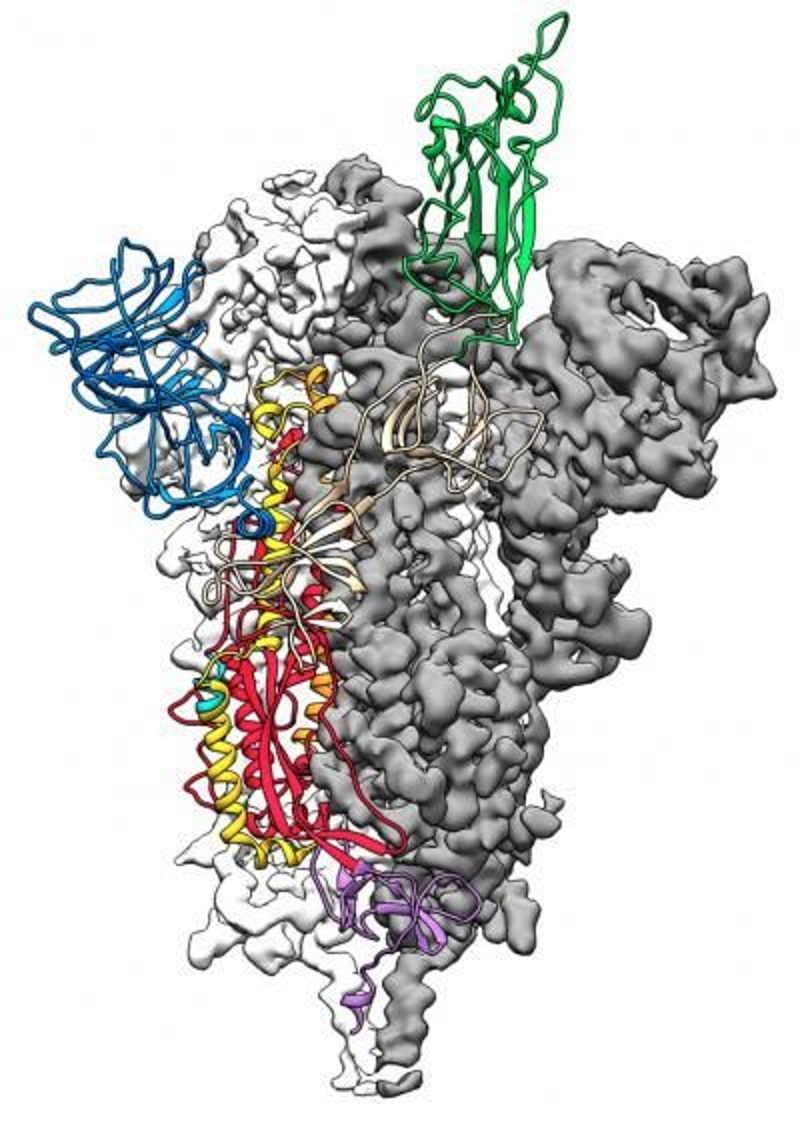
Researchers led by Qiang Zhou, a research fellow at Westlake University in Hangzhou, China, have revealed how the new virus attaches to a receptor on respiratory cells called angiotensin-converting enzyme 2, or ACE2.
"They have pictures all the way down at the level of the atoms that interact at the binding interface," Thomas Gallagher, a virologist at Loyola University Chicago who was not involved in the new research but studies coronavirus structure, told Live Science. That level of information is unusual at this stage of a new virus outbreak, he said.
"The virus outbreak only began to occur a couple months ago, and within that short period of time, these authors have come up with information that I think traditionally takes much longer," Gallagher said.
That's important, he said, because understanding how the virus enters cells can contribute to research on drugs or even a vaccine for the virus.
A viral entryway
To infect a human host, viruses must be able to gain entry into individual human cells. They use these cells' machinery to produce copies of themselves, which then spill out and spread to new cells.
On Feb. 19 in the journal Science, a research team led by scientists at the University of Texas at Austin described the tiny molecular key on SARS-CoV-2 that gives the virus entry into the cell. This key is called a spike protein, or S-protein. Last week, Zhou and his team described the rest of the puzzle: the structure of the ACE2 receptor protein (which is on the surfaces of respiratory cells) and how it and the spike protein interact. The researchers published their findings in the journal Science on March 4.

Zhou and his team used a tool called cryo-electron microscopy, which employs deeply frozen samples and electron beams to image the tiniest structures of biological molecules. The researchers found that the molecular bond between SARS-CoV-2's spike protein and ACE2 looks fairly similar to the binding pattern of the coronavirus that caused the outbreak of SARS in 2003. There are some differences, however, in the precise amino acids used to bind SARS-CoV-2 to that ACE2 receptor compared with the virus that causes SARS (severe acute respiratory syndrome), the researchers said.
"While some might consider the differences subtle," Gallagher said, "they might be meaningful with respect to the strength with which each of those viruses stick."
That "stickiness" could affect how easily a virus transmits from one person to another. If any given viral particle is more likely to enter a cell once it enters the human body, transmission of disease is more likely.
There are other coronaviruses that circulate regularly, causing upper respiratory infections that most people think of as the common cold. Those coronaviruses don't interact with the ACE2 receptor, Gallagher said, but rather, they get into the body using other receptors on human cells.
Coronavirus structure implications
The structure of SARS-CoV-2's "key" and the body's "lock" could theoretically provide a target for antiviral drugs that would stop the new coronavirus from getting into new cells. Most antiviral drugs already on the market focus on halting viral replication within the cell, so a drug that targeted viral entry would be new territory, Gallagher said.
"There is no effective clinical drug that will block that interaction that I know of" that's already in use, he said.
The viral spike protein is also a promising target for vaccines, because it's the part of the virus that interacts with its environment and so could be easily recognized by the immune system, Gallagher said.
Even so, developing either drugs or a vaccine will be a challenging task. Treatments and vaccines not only have to prove effective against the virus, but must also be safe for people, Gallagher said. U.S. Centers for Disease Control and Prevention officials have said that the earliest a coronavirus vaccine could be available is in a year to a year and a half.



Data without interpretation is utterly meaningless.
The model or narrative is the basis for framing the tests and for interpreting the data.
Science has to be self-honest in seeking to prove its model WRONG - in order to leave standing what cannot be - as yet shown false or incomplete.
The idea of a virus as invader is anthropomorphic.
Can you imagine a potassium ion invading a cell where its electrical properties fit the receptive needs of the call?
Exosomes are extra-cellular intercommunication, but those which are defined and assigned to be specific causes of specific diseases are called viruses - and an industry grows as a medical industrial complex.
Viral activity is part of the bodies bio-genome. It is true that there are no completely closed systems but an interplay of closed and open systems. Life is an open system that operates through patterns that can operate as closed systems - in terms of entropy or depletion and death.
Insofar as humans delve into the smallest sub particles they miss the fact that they have no meaning of function in themselves - but collectively embody probabilities of a relational alignment. Looking through a mechanistic mind is seeing only outer forms to then fit into mechanistic structures of the attempt to define and control how life works. It also uses processes for 'seeing' that introduce artefacts that are not present in vivo.
When microscopy has been developed to study in vivo it has been destroyed because what it revealed did not support the dominant invested and established model/narrative.
Proprietary science is not in the public domain excepting as Press Releases - and what is sought for and found is biased.
If expert toxicologists were to investigate instead of virologists (who are founded upon the study of the pathogen), we would open another perspective.
The body induces a sickness phase in response to certain toxcities and exposures according to its state of cellular health (true immunity) - which includes the biome - which is interfacing our psychic-emotional AND physical experience and exposure.
We live in an era where the headline and opening paragraph can be weaponised to support any agenda and are either effectively drafted as a legal disclaimer in disguise or retracted without publicity.
For example
HIV = AIDS!. It doesn't. But AIDS drugs were deadly.Many medical tests seek biomarkers that are presumed to indicate the presence of a defined specific disease condition. But are inaccurate as well as risking the spell of nocebo - in which the fear reaction can react so disproportionately as to degrade the functional health or kill the patient with correspondingly 'powerful' treatment. Overdosing aspirin was a major factor in the death rate of so called Spanish flu.
Medical Models are supposed to be founded in open and free scientific discovery - but have taken much of the faith and invested belief that was once aligned under religious or spiritual sense. But those who uncover what the established priesthood refuse to accept are denied just as were the prophets.
The blocking of the Messengers is the attempt to cling on to a closed system that is breaking down as a result of inherent conflicts that have to be addressed if life is to be renewed and wholeness of integrity restored.